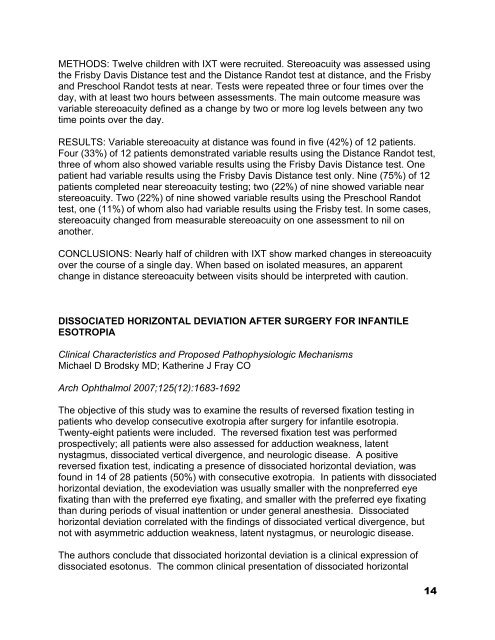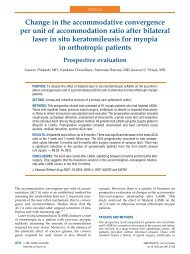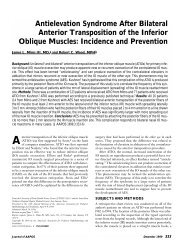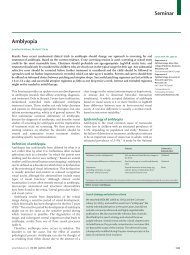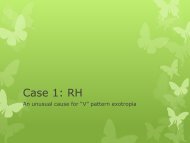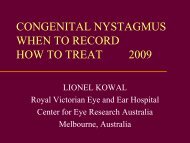What's new AAPOS 2008 - The Private Eye Clinic
What's new AAPOS 2008 - The Private Eye Clinic
What's new AAPOS 2008 - The Private Eye Clinic
You also want an ePaper? Increase the reach of your titles
YUMPU automatically turns print PDFs into web optimized ePapers that Google loves.
METHODS: Twelve children with IXT were recruited. Stereoacuity was assessed using<br />
the Frisby Davis Distance test and the Distance Randot test at distance, and the Frisby<br />
and Preschool Randot tests at near. Tests were repeated three or four times over the<br />
day, with at least two hours between assessments. <strong>The</strong> main outcome measure was<br />
variable stereoacuity defined as a change by two or more log levels between any two<br />
time points over the day.<br />
RESULTS: Variable stereoacuity at distance was found in five (42%) of 12 patients.<br />
Four (33%) of 12 patients demonstrated variable results using the Distance Randot test,<br />
three of whom also showed variable results using the Frisby Davis Distance test. One<br />
patient had variable results using the Frisby Davis Distance test only. Nine (75%) of 12<br />
patients completed near stereoacuity testing; two (22%) of nine showed variable near<br />
stereoacuity. Two (22%) of nine showed variable results using the Preschool Randot<br />
test, one (11%) of whom also had variable results using the Frisby test. In some cases,<br />
stereoacuity changed from measurable stereoacuity on one assessment to nil on<br />
another.<br />
CONCLUSIONS: Nearly half of children with IXT show marked changes in stereoacuity<br />
over the course of a single day. When based on isolated measures, an apparent<br />
change in distance stereoacuity between visits should be interpreted with caution.<br />
DISSOCIATED HORIZONTAL DEVIATION AFTER SURGERY FOR INFANTILE<br />
ESOTROPIA<br />
<strong>Clinic</strong>al Characteristics and Proposed Pathophysiologic Mechanisms<br />
Michael D Brodsky MD; Katherine J Fray CO<br />
Arch Ophthalmol 2007;125(12):1683-1692<br />
<strong>The</strong> objective of this study was to examine the results of reversed fixation testing in<br />
patients who develop consecutive exotropia after surgery for infantile esotropia.<br />
Twenty-eight patients were included. <strong>The</strong> reversed fixation test was performed<br />
prospectively; all patients were also assessed for adduction weakness, latent<br />
nystagmus, dissociated vertical divergence, and neurologic disease. A positive<br />
reversed fixation test, indicating a presence of dissociated horizontal deviation, was<br />
found in 14 of 28 patients (50%) with consecutive exotropia. In patients with dissociated<br />
horizontal deviation, the exodeviation was usually smaller with the nonpreferred eye<br />
fixating than with the preferred eye fixating, and smaller with the preferred eye fixating<br />
than during periods of visual inattention or under general anesthesia. Dissociated<br />
horizontal deviation correlated with the findings of dissociated vertical divergence, but<br />
not with asymmetric adduction weakness, latent nystagmus, or neurologic disease.<br />
<strong>The</strong> authors conclude that dissociated horizontal deviation is a clinical expression of<br />
dissociated esotonus. <strong>The</strong> common clinical presentation of dissociated horizontal<br />
14


